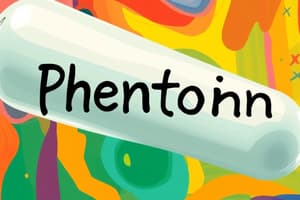Podcast
Questions and Answers
Which of the following medications, when taken concurrently with anticonvulsants, could potentially decrease the anticonvulsant's effectiveness?
Which of the following medications, when taken concurrently with anticonvulsants, could potentially decrease the anticonvulsant's effectiveness?
- Salicylates
- Cimetidine (Tagamet)
- Antidiabetic medications
- Opioids (correct)
Why is it crucial to establish therapeutic levels of anticonvulsants at the start of therapy?
Why is it crucial to establish therapeutic levels of anticonvulsants at the start of therapy?
- To minimize the need for future dosage adjustments.
- To immediately halt all seizure activity.
- To prevent interaction with other medications.
- To ensure effective seizure control without causing toxicity. (correct)
What potentially life-threatening condition can occur if a patient abruptly stops taking their anticonvulsant medication?
What potentially life-threatening condition can occur if a patient abruptly stops taking their anticonvulsant medication?
- Status epilepticus (correct)
- Pancytopenia
- Leukopenia
- Thrombocytopenia
Which common adverse effect of anticonvulsants typically diminishes over time?
Which common adverse effect of anticonvulsants typically diminishes over time?
Why might geriatric patients require lower doses of diazepam compared to younger adults?
Why might geriatric patients require lower doses of diazepam compared to younger adults?
Which serious adverse effect requires monitoring due to the potential for self-harm in patients taking lamotrigine (Lamictal)?
Which serious adverse effect requires monitoring due to the potential for self-harm in patients taking lamotrigine (Lamictal)?
A patient on anticonvulsants presents with nosebleeds, easy bruising, and petechiae. Which hematological adverse effect is MOST likely?
A patient on anticonvulsants presents with nosebleeds, easy bruising, and petechiae. Which hematological adverse effect is MOST likely?
A patient on anticonvulsants reports a sore throat, fever, and cough. Which hematological adverse effect is MOST likely?
A patient on anticonvulsants reports a sore throat, fever, and cough. Which hematological adverse effect is MOST likely?
Why is alcohol specifically contraindicated for patients taking anticonvulsants?
Why is alcohol specifically contraindicated for patients taking anticonvulsants?
A patient taking an anticonvulsant develops pancytopenia. Besides monitoring blood counts, what specific intervention should be IMMEDIATELY implemented in their oral hygiene routine to mitigate a potential consequence of this condition?
A patient taking an anticonvulsant develops pancytopenia. Besides monitoring blood counts, what specific intervention should be IMMEDIATELY implemented in their oral hygiene routine to mitigate a potential consequence of this condition?
Flashcards
CNS Depression
CNS Depression
A decrease in central nervous system activity, causing effects like drowsiness.
Anticonvulsant Interactions
Anticonvulsant Interactions
Certain drugs can increase or decrease the effectiveness of anticonvulsants.
Status Epilepticus
Status Epilepticus
A life-threatening condition due to continuous seizures, which can lead to respiratory arrest.
Therapeutic Levels
Therapeutic Levels
Signup and view all the flashcards
Drowsiness in Anticonvulsants
Drowsiness in Anticonvulsants
Signup and view all the flashcards
Geriatric Dosage Adjustment
Geriatric Dosage Adjustment
Signup and view all the flashcards
Pancytopenia
Pancytopenia
Signup and view all the flashcards
Signs of Infection
Signs of Infection
Signup and view all the flashcards
Monitoring Plasma Levels
Monitoring Plasma Levels
Signup and view all the flashcards
Alcohol Interaction
Alcohol Interaction
Signup and view all the flashcards
Study Notes
CNS Depression and Interactions
- CNS depressants worsen the effects of anticonvulsants, increasing CNS depression.
- Salicylates and cimetidine increase the effects of anticonvulsants.
- Opioids decrease anticonvulsant effectiveness, potentially causing seizures.
- Oral contraceptives can interfere with anticonvulsant efficacy.
- Alcohol increases the depressant effects of anticonvulsants.
- Antidiabetic medications can raise blood glucose levels in patients taking anticonvulsants.
Therapeutic Levels and Adjustments
- Therapeutic levels for anticonvulsants must be established, requiring frequent adjustments initially.
- Plasma levels are monitored via blood tests for therapeutic ranges and to prevent toxicity.
- Therapeutic ranges ensure effective seizure control without toxicity.
Abrupt Discontinuation and Status Epilepticus
- Abrupt discontinuation of anticonvulsants can lead to status epilepticus, a dangerous, life-threatening condition of continuous seizures.
- Status epilepticus can cause respiratory arrest.
Common Adverse Effects
- Drowsiness is a common adverse effect of anticonvulsants, typically decreasing over time.
- Safety is compromised by the potential for drowsiness and impaired coordination.
Geriatric Considerations
- Geriatric patients may need lower diazepam doses to prevent oversedation.
- Decreased kidney and liver function in the elderly can affect drug metabolism, necessitating dosage adjustments.
Serious Adverse Effects
- Cardiac arrest and apnea are possible with anticonvulsants.
- A severe, potentially fatal rash can occur with lamotrigine (Lamictal).
- Suicidal ideation should be monitored in patients taking lamotrigine (Lamictal).
- Pancytopenia (a drop in all blood cell counts) can occur with anticonvulsants.
- Thrombocytopenia (low platelets) causes bleeding (e.g., nosebleeds, easy bruising, petechiae).
- Leukopenia (low white blood cells) increases infection risk (e.g., sore throat, fever, cough).
- Anemia (low red blood cells) causes fatigue and malaise.
- Use soft toothbrushes to prevent bleeding gums.
Monitoring and Administration
- Plasma levels are periodically monitored to maintain therapeutic levels.
- Monitoring frequency varies by doctor and patient needs.
- Do not put anything in the mouth of a seizing person.
- Avoid alcohol, as it's a CNS depressant.
Barbiturates: Respiratory Depression and Other Effects
- Barbiturates depress the respiratory system, requiring frequent vital signs, especially in new patients.
- Resuscitation equipment should be available.
- Barbiturates should not be used in patients with severe respiratory issues.
- Drowsiness, sedation, and depression are common barbiturate side effects.
- Elderly patients may experience paradoxical excitement and agitation instead of sedation.
Diazepam: IV Administration and Short Duration
- Diazepam is given intravenously (IV) to quickly control seizures.
- Diazepam is the preferred drug for status epilepticus.
- Diazepam has a short duration of action.
Studying That Suits You
Use AI to generate personalized quizzes and flashcards to suit your learning preferences.




